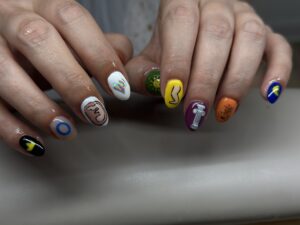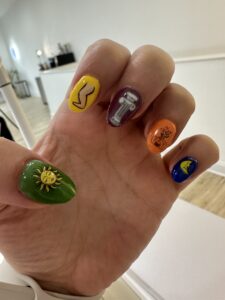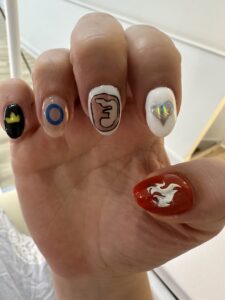by Anna Coufal
“The ten sefirot(pl of sefirah) In Kabbalah, the 10 “attributes” – channels of Divine energy – via which God interacts with creation. are the basis- the number of the ten fingers, five opposite five, and the covenant of unity is exactly in the middle by the word of the tongue and mouth and the circumcision of the flesh.”
So states Sefer Yetzirah, an enigmatic, mystical, and perhaps even magical medieval Jewish text. This foundational text has intrigued and baffled countless generations of kabbalists who sought to delve deeper into what the ten sefirot are and how they differentiate and ultimately unite to compose and influence the God we know and the universe we inhabit. Despite the enigmatic nature of the kabbalistic texts, the sefirot remain hugely popular today in the Jewish imagination. In this period between PesachPassover is a major Jewish holiday that commemorates the Jewish people's liberation from slavery and Exodus from Egypt. Its Hebrew name is Pesakh. Its name derives from the tenth plague, in which God "passed over" the homes of the Jewish firstborn, slaying only the Egyptian firstborn. Passover is celebrated for a week, and many diaspora Jews celebrate for eight days. The holiday begins at home at a seder meal and ritual the first (and sometimes second) night. Jews tell the story of the Exodus using a text called the haggadah, and eat specific food (matzah, maror, haroset, etc). and ShavuotShavuot is the holiday fifty days after Passover and commemorates when the Israelite liberation from Egypt culminates with the giving of the Torah. Traditionally, Jews study in an all-night study session, eat dairy products (one interpretation is that the Torah is like milk to us), and read both the Ten Commandments and the Book of Ruth., many of us have been contemplating the seven lower sefirot as we count the OmerFrom the second day of Passover until Shavuot, Jews count seven weeks – seven times seven days – to commemorate the period between the Exodus from Egypt and the Revelation at Sinai. When the Temple stood, a certain measure (omer) of barley was offered on the altar each day; today, we merely count out the days..

As someone who doesn’t always wear a head covering or tzit-tzit, I’ve been experimenting with nail art as a way to outwardly express and inwardly remember my Judaism as well as to feel in sync with Jewish time. In my opinion, nail art is one of the most interesting art forms of the 21st century- it is truly remarkable what some nail techs are capable of creating. For Pesach, I got French tips that had waves instead of the traditional white line to commemorate crossing the Sea of Reeds. For this period leading up to Shavuot, I decided to go with a sefirot theme. Based on traditional colors and symbols associated with each sefirah, I designed each nail with the help of my wonderful nail tech, Chelsea. Some images we found as stickers, and Chelsea painted the odd ones we couldn’t find. Special thanks to Chelsea and O’Studio in Philly! And special thanks to my professor, Joel Hecker, for teaching me about kabbalahThe tradition of Jewish mystical interpretation of sacred texts. The foundational kabbalistic text is the Zohar. and inspiring this project.

- Keter: Symbolized by the crown and the color black, the first sefirah is keter. Because the ten emanations appear to be finite, the kabbalists envisioned an infinite divinity, ein sof, that connects with this first sefirah, desiring or willing to come into being. This sefirah is also known as ratzon, Will of Wills, ayin, keter elyon or rum ma’alah. Here it is illustrated as a crown.
- Chochmah: The second sefirah is chochmah, which means wisdom. Chochmah is the primordial point, the origin of existence known as “hidden thought” or “seed of thought.” This type of thought is undifferentiated. It also corresponds to father. Chochmah and sometimes its complement, binah, have been linked with the brain. Here it is symbolized by a circle.
- Binah: Binah is the third sefirah, and it means understanding. Unlike Chochmah, which is active and full of potential energy, Binah is more of a receptive energy that complements its counterpart. It can also refer to a palace, discernment, or teshuvah. Corresponding to the heart, the womb and to mother, it seeks union with chochmah in order to produce the seven “lower” sefirot. Check out that womb! (Thank you Chelsea!)
- Chesed: As mentioned before, all of the following seven sefirot are said to have emanated from the womb of Binah as impregnated by Chochmah. Chesed, our fourth sefirah, means love. Also known as Gedulah, or Greatness, chesed is associated with the right arm and AbrahamAbraham is the first patriarch and the father of the Jewish people. He is the husband of Sarah and the father of Isaac and Ishmael. God's covenant - that we will be a great people and inherit the land of Israel - begins with Abraham and is marked by his circumcision, the first in Jewish history. His Hebrew name is Avraham. as well as the color white and water. Its complement is gevurah, the two must always work together. Here chesed is symbolized by a heart.
- Gevurah: Gevurah, our fifth sefirah, is also known as “din,” or judgment, and it refers to strength or power. Without chesed, gevurah can be an overpowering and destructive force, but in moderation it serves to create firm boundaries. It is associated with the left arm and IsaacAbraham and Sarah's much-longed-for son and the second Jewish patriarch. Isaac is nearly sacrificed by his father at God's command (Genesis 22). He is married to Rebecca and is the father of Esau and Jacob. His Hebrew name is Yitzchak. as well as the color red and fire. It is represented here by a flame.
- Tiferet: The synthesis of Chesed and Gevurah is our sixth sefirah, Tiferet, which means beauty, splendor, or balance. Sometimes it is depicted as being in love/having sex with the last sefirah, malkhut. Typically associated with the sun, the torso, and the spine, it is also connected with the colors green, yellow and purple. The rest of the sefirot emanate from tiferet. Here it is symbolized by the sun.
- Netzach: Netzach, which means endurance or victory, is a pair with Hod. Together, they symbolize the pillars of the temple, kidneys, and prophecy. Netzach is specifically associated with MosesThe quintessential Jewish leader who spoke face to face with God, unlike any other prophet, and who freed the people from Egypt, led them through the desert for forty years, and received the Torah on Mt. Sinai. His Hebrew name is Moshe. and the right leg. Here it is symbolized by a leg.
- Hod: As mentioned previously, Hod is a pair with Netzach. Together, they symbolize the pillars of the temple, kidneys, and prophecy. Hod means majesty or humility, and it is associated with AaronBrother of Moses, chosen as Moses' interlocutor. His Hebrew name is Aharon. and the left leg. It is illustrated here by a pillar.
- Yesod: The penultimate sefirah means foundation or connection. It is associated with covenant and with the tree of life, as well as with phallus, breasts, peace, and JosephJacob's eldest son by his beloved wife, Rachel. Joseph, the dreamer, was his father's favorite and nearly murdered by his brothers. Sold into slavery, he became viceroy of Egypt where he ultimately saves the Egyptians and also his own family from starvation. His Hebrew name is Yosef/. It connects the rest of the sefirot with the final sefirah. Here it is represented by a “tree” (or a woman with flowers growing instead of a head- same thing).
- Malkhut: The final sefirah means kingdom. It is also known as ShekhinahThe feminine name of God, expounded upon in the rabbinic era and then by the Kabbalists in extensive literature on the feminine attributes of the divine., which is the feminine presence of G-d that dwells on earth. The symbolism of malkhut is rich- it is commonly associated with land, moon, queen, bride, princess, apple orchard, mouth, rainbow or the color blue. Sometimes it is depicted as being in love/having sex with the sixth sefirah, tiferet. It is represented here by the moon.

Anna Coufal is a rabbinical student at RRC.





